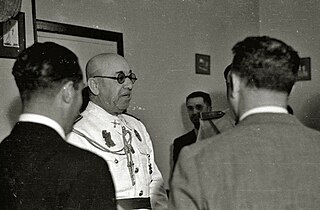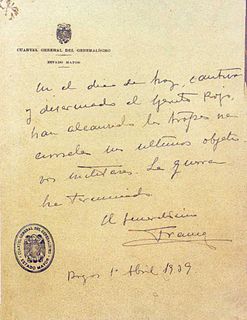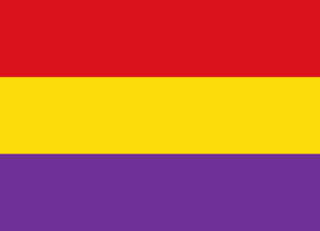Domingo Rey d'Harcourt | |
|---|---|
| Born | 1883 Pamplona, Spain |
| Died | February 7. 1939 Ponts de Molins, Catalonia |
| Allegiance | |
| Service/ | Spanish Army |
| Years of service | 1901–1939 |
| Rank | Colonel of artillery |
| Commands held | Teruel Garrison |
| Battles/wars | Spanish Civil War |
Domingo Rey d'Harcourt (Born, Pamplona, Spain, 1883 - died, Ponts de Molins, Catalonia, Spain, February 7. 1939) was a Nationalist commander during the Spanish Civil War.

Spain, officially the Kingdom of Spain, is a country mostly located in Europe. Its continental European territory is situated on the Iberian Peninsula. Its territory also includes two archipelagoes: the Canary Islands off the coast of Africa, and the Balearic Islands in the Mediterranean Sea. The African enclaves of Ceuta, Melilla, and Peñón de Vélez de la Gomera make Spain the only European country to have a physical border with an African country (Morocco). Several small islands in the Alboran Sea are also part of Spanish territory. The country's mainland is bordered to the south and east by the Mediterranean Sea except for a small land boundary with Gibraltar; to the north and northeast by France, Andorra, and the Bay of Biscay; and to the west and northwest by Portugal and the Atlantic Ocean.

Catalonia is an autonomous community in Spain on the northeastern corner of the Iberian Peninsula, designated as a nationality by its Statute of Autonomy. Catalonia consists of four provinces: Barcelona, Girona, Lleida, and Tarragona. The capital and largest city is Barcelona, the second-most populated municipality in Spain and the core of the sixth most populous urban area in the European Union. It comprises most of the territory of the former Principality of Catalonia. It is bordered by France (Occitanie) and Andorra to the north, the Mediterranean Sea to the east, and the Spanish autonomous communities of Aragon to the west and Valencia to the south. The official languages are Catalan, Spanish, and the Aranese dialect of Occitan.

The Spanish Civil War took place from 1936 to 1939. Republicans loyal to the left-leaning Second Spanish Republic, in alliance with the Anarchists and Communists, fought against the Nationalists, an alliance of Falangists, Monarchists, and Catholics, led by General Francisco Franco. The war was known as a struggle between democracy and fascism, particularly due to the international political climate. The Nationalists won the war in early 1939 and ruled Spain until Franco's death in November 1975.
He had risen to Colonel of artillery, and joined the military rising against the Republican Government that became the Spanish Civil War.
Colonel is a senior military officer rank below the brigadier and general officer ranks. However, in some small military forces, such as those of Monaco or the Vatican, colonel is the highest rank. It is also used in some police forces and paramilitary organizations.

Artillery is a class of heavy military weapons built to fire munitions far beyond the range and power of infantry's small arms. Early artillery development focused on the ability to breach defensive walls, and fortifications during sieges, and led to heavy, fairly immobile siege engines. As technology improved, lighter, more mobile field artillery cannons developed for battlefield use. This development continues today; modern self-propelled artillery vehicles are highly mobile weapons of great versatility providing the large share of an army's total firepower.

The Spanish Republic, commonly known as the Second Spanish Republic, was the democratic government that existed in Spain from 1931 to 1939. The Republic was proclaimed on 14 April 1931, after the deposition of Alfonso XIII, and it lost the Spanish Civil War on 1 April 1939 to the rebel faction, that would establish a military dictatorship under the rule of Francisco Franco.
During the Civil War Rey d'Harcourt was the commander of the Nationalist garrison of the city of Teruel during the Battle of Teruel. Heavily out numbered Rey d'Harcourt make a last stand in four key points of the city, the Civil Governor's Building, the Bank of Spain, the Convent of Santa Clara and the Seminary. Republican Radio Barcelona announced that Teruel had fallen, but Rey d'Harcourt and the remnants of the 4,000 man garrison still held out. [1] With no water, few medical supplies and little food he was finally forced to surrender on January 8, 1938.
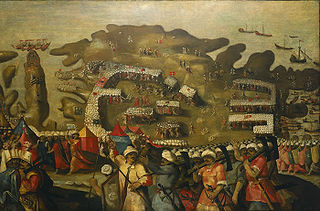
Garrison is the collective term for any body of troops stationed in a particular location, originally to guard it, but now often simply using it as a home base. The garrison is usually in a city, town, fort, castle, ship or similar. "Garrison town" is a common expression for any town that has a military base nearby.

Teruel is a city in Aragon, located in eastern Spain, and is also the capital of Teruel Province. It has a population of 35,675 in 2014 making it the least populated provincial capital in the country. It is noted for its harsh climate, with a very big daily variation on temperatures and its renowned jamón serrano, its pottery, its surrounding archaeological sites, rock outcrops containing some of the oldest dinosaur remains of the Iberian Peninsula, and its famous events: La Vaquilla del Ángel during the weekend closest to 10 July and "Bodas de Isabel de Segura" around the third weekend of February.

The Battle of Teruel was fought in and around the city of Teruel during the Spanish Civil War. The combatants fought the battle between December 1937 and February 1938, during the worst Spanish winter in twenty years. The battle was one of the bloodier actions of the war with the city changing hands several times, first falling to the Republicans and eventually being re-taken by the Nationalists. In the course of the fighting, Teruel was subjected to heavy artillery and aerial bombardment. The two sides suffered over 140,000 casualties between them in the two-month battle. It was a decisive battle of the war, as Francisco Franco's use of his superiority in men and material in regaining Teruel made it the military turning point of the war.
Despite his heroism, his surrender was criticized by many in the Nationalist high command.
He was jailed for treason against the Republic first in Valencia and then in Barcelona. During the Nationalist Catalonia Offensive he was taken towards the French border and was killed by his guards along with forty-two other prisoners of the Battle of Teruel, including Anselmo Polanco, Bishop of Teruel. [2]

In law, treason is criminal disloyalty to the state. It is a crime that covers some of the more extreme acts against one's nation or sovereign. This usually includes things such as participating in a war against one's native country, attempting to overthrow its government, spying on its military, its diplomats, or its secret services for a hostile and foreign power, or attempting to kill its head of state. A person who commits treason is known in law as a traitor.
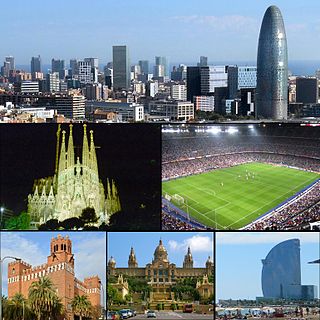
Barcelona is a city in Spain. It is the capital and largest city of the autonomous community of Catalonia, as well as the second most populous municipality of Spain. With a population of 1.6 million within city limits, its urban area extends to numerous neighbouring municipalities within the Province of Barcelona and is home to around 4.8 million people, making it the sixth most populous urban area in the European Union after Paris, London, Madrid, the Ruhr area and Milan. It is one of the largest metropolises on the Mediterranean Sea, located on the coast between the mouths of the rivers Llobregat and Besòs, and bounded to the west by the Serra de Collserola mountain range, the tallest peak of which is 512 metres high.

The Catalonia Offensive was part of the Spanish Civil War. The Nationalist Army started the offensive on December 23, 1938, and rapidly conquered Republican-held Catalonia with Barcelona. Barcelona was captured on January 26, 1939. The Republican government headed for the French border. Thousands of people fleeing the Nationalists also crossed the frontier in the following month, to be placed in internment camps. Franco closed the border with France by February 10, 1939.
